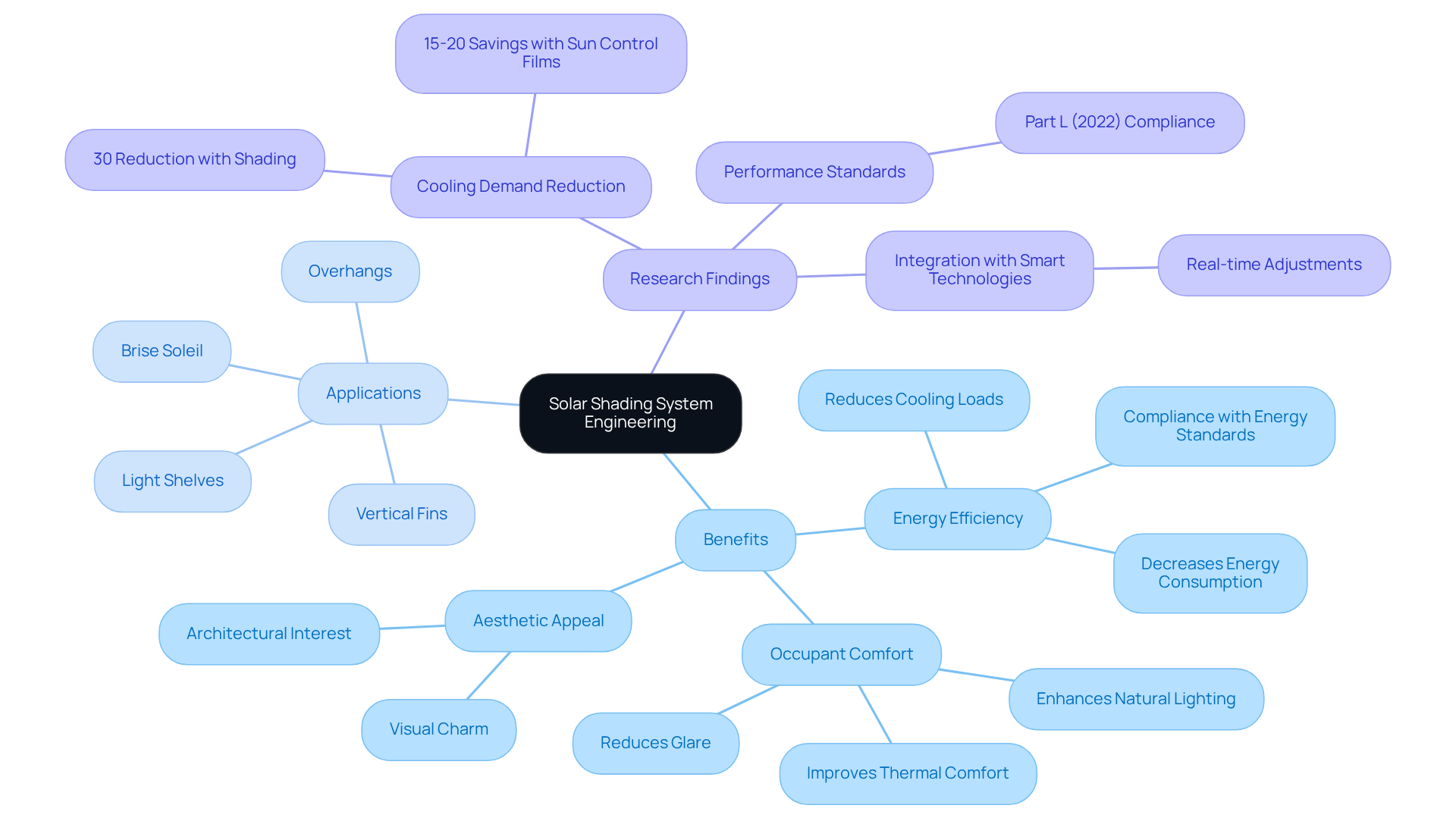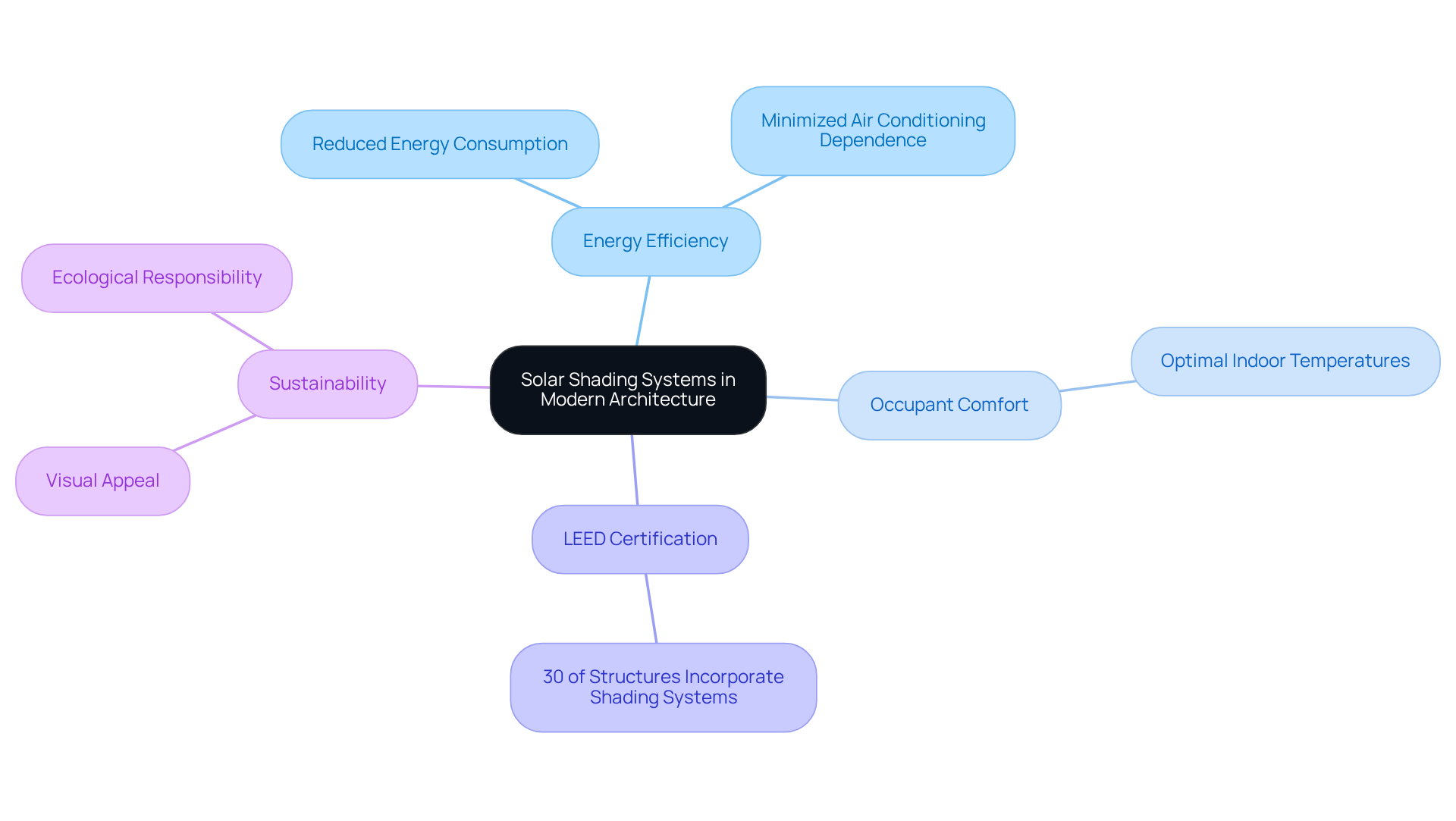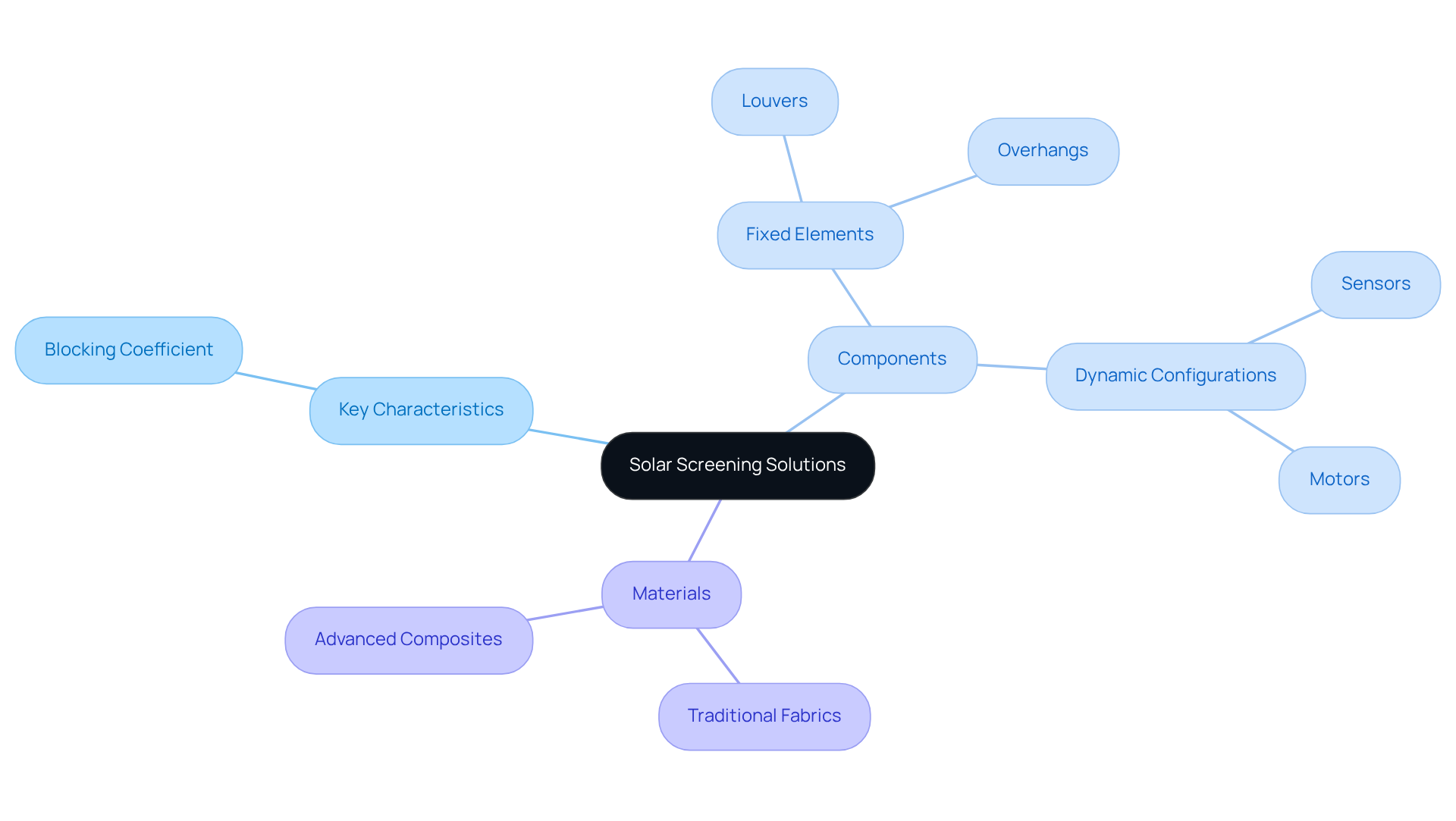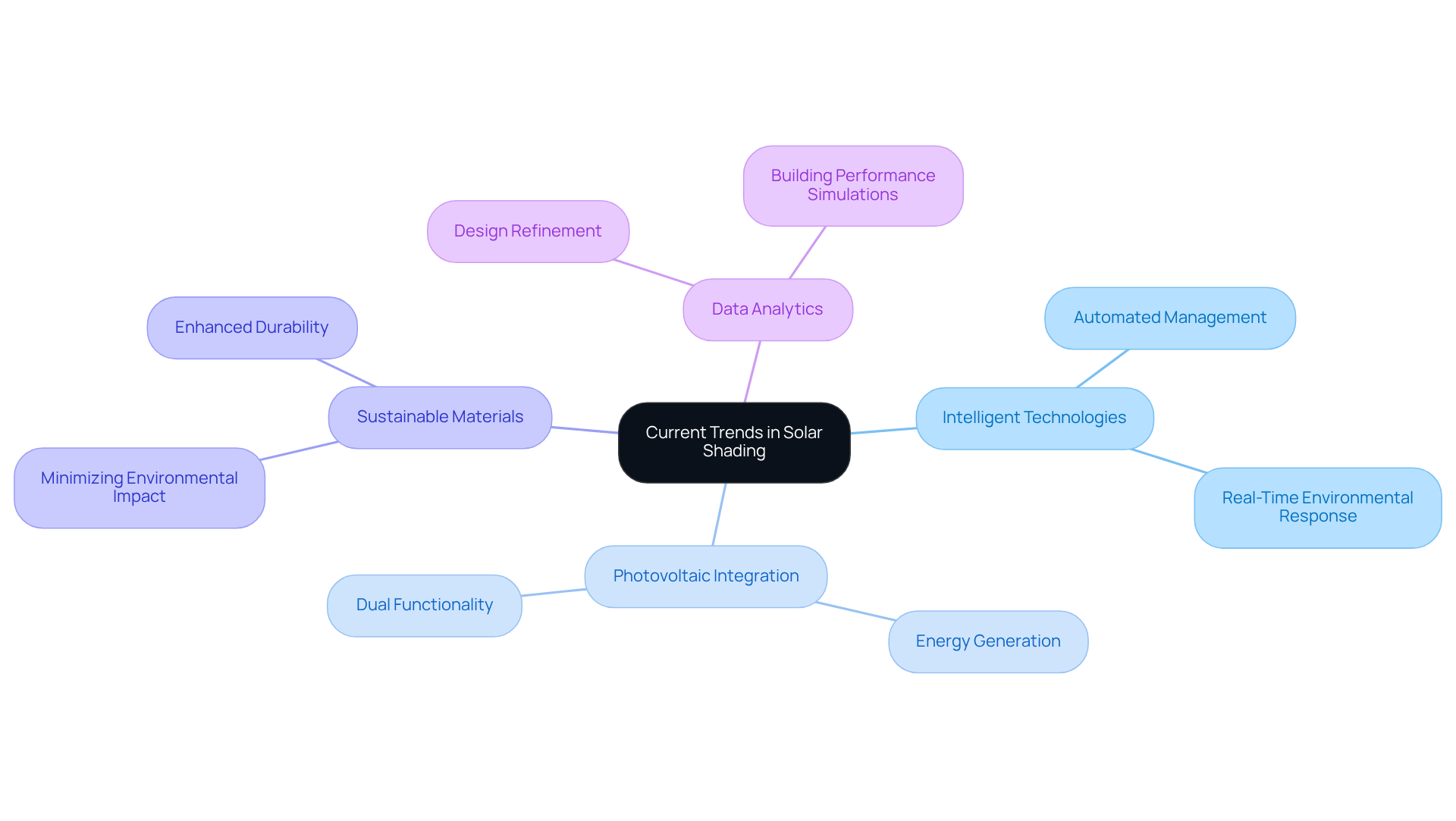Overview
The article underscores the critical importance of solar shading system engineering in contemporary architectural design. It highlights how these systems not only enhance energy efficiency but also significantly improve occupant comfort. By detailing the mechanisms through which these systems effectively reduce heat gain and glare, promote sustainable practices, and incorporate advanced technologies, the article illustrates their vital contribution to both the efficiency and aesthetic appeal of modern buildings.
Introduction
The integration of solar shading systems stands as a cornerstone of modern architectural design, underscoring a robust commitment to sustainability and energy efficiency. These innovative solutions not only enhance the aesthetic appeal of buildings but also play a critical role in minimizing energy consumption and improving occupant comfort. As architects increasingly embrace these technologies, questions emerge regarding the optimal strategies for implementation and the delicate balance between functionality and design. How can the engineering of solar shading systems evolve to meet the demands of contemporary architecture while effectively addressing environmental challenges?
Define Solar Shading System Engineering
Solar shading system engineering plays a pivotal role in the design and execution of systems that manage sunlight entering a building. These systems can be either stationary or adjustable, employing a variety of materials and technologies to enhance resource efficiency and occupant comfort. By strategically blocking or filtering sunlight, solar shading system engineering effectively mitigates heat gain, reduces glare, and enhances natural lighting, thereby supporting sustainable building practices. This engineering discipline, particularly solar shading system engineering, seamlessly integrates architectural design with environmental considerations, establishing it as a critical component of modern construction projects.
Architects recognize the importance of these systems, as they not only contribute to resource conservation but also elevate the aesthetic appeal of buildings. Innovative solutions, such as brise soleil and overhangs, have been successfully incorporated into contemporary designs, showcasing their effectiveness in improving performance while retaining visual charm. The benefits of sun-blocking installations, as highlighted in solar shading system engineering, extend beyond mere aesthetics; they are essential for achieving energy efficiency, reducing reliance on mechanical cooling, and enhancing overall occupant comfort.
Research indicates that sunlight protection can decrease cooling demands by as much as 30%, and sun control films can yield savings of 15-20% across various climates. Furthermore, adherence to performance standards, such as Part L (2022), underscores the necessity of integrating these frameworks into architectural designs. The fusion of sun protection solutions with intelligent technologies reflects current trends, enabling real-time adjustments that enhance energy efficiency and resident comfort.
In conclusion, leveraging solar shading system engineering is not just a matter of compliance; it is a strategic move towards a more sustainable and comfortable built environment.

Contextualize the Importance in Modern Architecture
In modern architecture, solar shading system engineering has emerged as an essential solution in the pursuit of efficiency and sustainability. With the increasing prevalence of glass facades and expansive windows, effective sunlight management has become imperative.
Solar shading system engineering is essential as these systems drastically reduce energy consumption by minimizing reliance on air conditioning, while simultaneously enhancing occupant comfort through the maintenance of optimal indoor temperatures. Notably, approximately 30% of structures pursuing LEED certification incorporate solar shading system engineering, underscoring their importance in eco-friendly design practices.
Sustainability advocates emphasize the integration of solar shading system engineering in architectural designs, highlighting its dual benefits of visual appeal and ecological responsibility. By strategically implementing solar shading system engineering, architects can create spaces that not only fulfill energy efficiency criteria but also contribute to a more sustainable future.

Trace the Historical Development of Solar Shading Systems
The evolution of sunlight blocking has seen remarkable advancements over the centuries. Early architectural designs incorporated natural cover elements—overhangs, awnings, and trees—to shield buildings from direct sunlight. With the advent of contemporary materials and technologies, solar shading system engineering has become increasingly sophisticated. The introduction of dynamic light control devices within solar shading system engineering, capable of adjusting based on sunlight intensity and angle, signifies a substantial leap forward in this field. Today, innovations such as automated light control solutions and intelligent technologies, along with solar shading system engineering, facilitate real-time modifications that enhance energy efficiency and elevate user comfort. This historical perspective underscores the ongoing development of solar shading system engineering as an essential component of sustainable architecture.
Significantly, the global light control markets were valued at USD 11.3 billion in 2022 and are projected to reach USD 15.80 billion by 2031, expanding at a CAGR of 3.8%. North America commands the largest market share, with a forecasted CAGR of 3.5%, driven by a growing demand for automated and motorized solutions. Furthermore, innovations like personalized coverage plans and automated mechanisms illustrate the contemporary applications of solar shading system engineering technologies. These advancements not only reduce energy consumption but also provide critical sun defense, emphasizing their importance in sustainable design.

Identify Key Characteristics and Components
Solar screening solutions play a pivotal role in controlling light and heat absorption, significantly enhancing visual comfort and achieving substantial energy savings. These systems comprise various components, including:
- Fixed elements like louvers and overhangs
- Dynamic configurations equipped with sensors and motors for automated adjustments
The materials used for sun protection range from traditional fabrics to advanced composites, specifically designed for durability and thermal efficiency. The effectiveness of these systems is often measured by their blocking coefficient, which indicates the percentage of sunlight obstructed. Understanding these characteristics and components is essential for architects and engineers dedicated to solar shading system engineering in the design of energy-efficient buildings. As the demand for sustainable architecture continues to rise, the integration of innovative sunlight control solutions becomes increasingly critical in contemporary design.

Explore Current Trends and Innovations in Solar Shading
Current trends in solar shading system engineering are increasingly characterized by the integration of intelligent technologies that facilitate automated management in response to real-time environmental conditions. Innovations such as solar shading system engineering with photovoltaic integration are gaining momentum, allowing buildings to generate energy while simultaneously providing shade. This dual functionality enhances efficiency and supports sustainability goals.
For instance, recent studies indicate that buildings utilizing these systems can achieve significant reductions in energy consumption, with some reports noting decreases of up to 22.3% during winter months. Moreover, there is a growing emphasis on the use of sustainable materials and designs aimed at minimizing environmental impact. The application of data analytics and building performance simulations is becoming more commonplace, enabling architects to refine their solar shading system engineering strategies during the design phase.
These advancements signal a significant shift towards more intelligent and sustainable construction practices that prioritize both efficiency and occupant comfort. As Thomas Edison aptly remarked, 'I’d put my money on the sun and sunlight energy.' This perspective highlights the increasing acknowledgment of solar innovations in enhancing building performance.

Conclusion
Solar shading system engineering is crucial in contemporary architectural design, emphasizing the effective management of sunlight to boost energy efficiency and occupant comfort. By incorporating these systems into building designs, architects can create environments that fulfill aesthetic aspirations while adhering to sustainability goals, thereby fostering a more resource-efficient built landscape.
This article explores various dimensions of solar shading systems, from their historical development to cutting-edge technological innovations. Key insights reveal their substantial impact on energy consumption reduction—potentially decreasing cooling demands by as much as 30%—alongside the necessity of adhering to performance standards. Furthermore, the discussion underscores the dual advantages of aesthetic value and ecological responsibility, illustrating how pioneering solutions such as automated light control and photovoltaic integration are redefining the future of sustainable architecture.
Understanding the pivotal role of solar shading systems in building design is imperative for architects and engineers committed to energy efficiency and occupant satisfaction. As the push for sustainable practices intensifies, adopting these technologies not only bolsters building performance but also aligns with broader environmental objectives. The integration of solar shading solutions transcends mere trend; it represents an essential stride toward crafting a sustainable future in architecture.
Frequently Asked Questions
What is solar shading system engineering?
Solar shading system engineering involves designing and implementing systems that manage sunlight entering a building, using various materials and technologies to enhance resource efficiency and occupant comfort. It helps mitigate heat gain, reduce glare, and improve natural lighting.
How do solar shading systems contribute to sustainable building practices?
By blocking or filtering sunlight, solar shading systems reduce reliance on mechanical cooling, enhance energy efficiency, and improve occupant comfort, making them critical for sustainable building practices.
What are some common types of solar shading solutions?
Common solutions include brise soleil and overhangs, which effectively improve building performance while adding visual appeal.
What impact can sunlight protection have on cooling demands?
Sunlight protection can decrease cooling demands by as much as 30%, leading to significant energy savings.
How do sun control films contribute to energy savings?
Sun control films can yield energy savings of 15-20% across various climates by reducing heat gain from sunlight.
Why is it important to adhere to performance standards like Part L (2022) in solar shading system engineering?
Adhering to performance standards ensures that solar shading systems are effectively integrated into architectural designs, promoting energy efficiency and compliance with sustainability regulations.
How does modern architecture utilize solar shading system engineering?
In modern architecture, solar shading system engineering is essential for managing sunlight in buildings with glass facades and large windows, significantly reducing energy consumption and enhancing occupant comfort.
What percentage of LEED-certified structures incorporate solar shading system engineering?
Approximately 30% of structures pursuing LEED certification incorporate solar shading system engineering, highlighting its importance in eco-friendly design practices.
What are the dual benefits of integrating solar shading system engineering in architectural designs?
The dual benefits include enhancing visual appeal and promoting ecological responsibility, contributing to both aesthetic and sustainable architectural outcomes.
List of Sources
- Define Solar Shading System Engineering
- A review of smart solar shading systems and their applications: Opportunities in cold climate zones (https://sciencedirect.com/science/article/abs/pii/S2352710222015893)
- Retrofitting Solar Shading to Enhance Energy Efficiency (https://enviroscreen.org.uk/retrofitting-solar-shading-existing-buildings)
- Quotes About Solar Power: 50 Picks to Light Up Your Life - Lumify Energy (https://lumifyenergy.com/blog/quotes-about-solar-power)
- Multi-objective Optimization of Window and Shading Systems for Enhanced Office Building Performance: A Case Study in Qom, Iran (https://solarlits.com/jd/12-91)
- None (https://dokumen.pub/solar-shading-systems-design-performance-and-integrated-photovoltaics-1st-ed-978-3-030-11616-3978-3-030-11617-0.html)
- Contextualize the Importance in Modern Architecture
- LEED-certified building area 2025, by building type| Statista (https://statista.com/statistics/1356672/leed-certified-building-surface-area-us-by-building-type)
- Trace the Historical Development of Solar Shading Systems
- Global Solar Shading Systems Market Size is projected to reach USD 15.80 billion by 2031, growing at a CAGR of 3.8%: Straits Research (https://globenewswire.com/news-release/2024/03/13/2845443/0/en/Global-Solar-Shading-Systems-Market-Size-is-projected-to-reach-USD-15-80-billion-by-2031-growing-at-a-CAGR-of-3-8-Straits-Research.html)
- None (https://dokumen.pub/solar-shading-systems-design-performance-and-integrated-photovoltaics-1st-ed-978-3-030-11616-3978-3-030-11617-0.html)
- Identify Key Characteristics and Components
- Construction Investments Boost Solar Shading Systems Market (https://worldconstructiontoday.com/news/construction-investments-boost-solar-shading-systems-market)
- Quotes About Solar Power: 50 Picks to Light Up Your Life - Lumify Energy (https://lumifyenergy.com/blog/quotes-about-solar-power)
- Danpalon Louvre Shading Device for Capire Nursery | Danpal (https://danpal.com.au/case_studies/danpalon-louvre-shading-device-nursery-capire)
- Solar Shading Systems Market Poised for Significant Growth : Key Trends & Forecasts 2031 (https://openpr.com/news/4101547/solar-shading-systems-market-poised-for-significant-growth-key)
- Top Solar Quotes (https://inventionsolar.com/solar-quotes)
- Explore Current Trends and Innovations in Solar Shading
- A review of smart solar shading systems and their applications: Opportunities in cold climate zones (https://sciencedirect.com/science/article/abs/pii/S2352710222015893)
- Quotes About Solar Power: 50 Picks to Light Up Your Life - Lumify Energy (https://lumifyenergy.com/blog/quotes-about-solar-power)
- Top Ten Quotes about Solar Power (https://harnessoursun.com/top-ten-quotes-about-solar-power)
- 20 Quotes To Get You Inspired For a Renewable Future - Solstice (https://solstice.us/solstice-blog/20-quotes-for-a-renewable-future)
- Top Solar Quotes (https://inventionsolar.com/solar-quotes)




